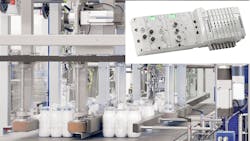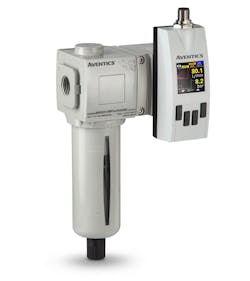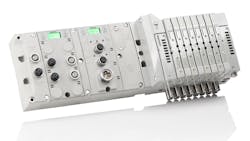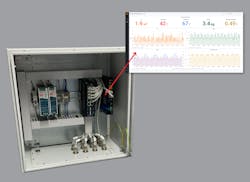The IIoT Journey Starts With a Good Partnership
All industries have come to recognize the power of the Industrial Internet of Things (IIoT) and digital transformation. Yet many still struggle with what digitalization means to them and where they should start.
Unprecedented demand, strained supply chains and personnel shortages have prompted some to focus on applying digitalization for predictive maintenance and maximizing overall equipment effectiveness. For others, implementing monitoring and control of all energy sources—water, air, gas, electricity and steam—has become essential to managing resources and satisfying growing customer demand for sustainability.
Every facility has a different set of problems to solve, so each IIoT journey begins in its own way. This lack of a clear path can make getting started with IIoT feel overwhelming. Support from knowledgeable suppliers who understand IIoT is therefore critical.
These expert suppliers help facilities evaluate their distinct needs and guide the journey in ways that make the most sense. Suppliers also have scalable solutions. Once a facility takes that first step and finds success, they can continue to build on what they have learned.
Choosing a Supplier Partner
When first setting out on their digital transformation and IIoT journey, many quickly discover a wide variety of one-size-fits-all solutions. These are incredibly appealing because they ostensibly take a complex challenge and treat it as though it can be solved with one product, usually software. For those just starting, the capital investment in these solution types can be so high that it can be a non-starter, discouraging them from pursuing digitalization initiatives. They may also find that some solutions require a specific component brand, which can drive the cost up even further.
Still another problem, and one of the biggest barriers to long-term success with digital transformation, is lack of scalability. For instance, a facility may start with a pilot program at the machine level and, down the road, discover that software limitations prevent them from transferring a machine-level success to other applications using the same tools. In this case, the halting lack of scalability can expend an often already limited budget and frustrate efforts to deliver the proof of concept and momentum to advance the initiative.
All these pitfalls can be avoided by taking a more strategic approach to where you begin your IIoT journey and by choosing the right suppliers to guide you. Here is some advice for both:
Start Small
Most facilities aren’t ready to jump into IIoT with both feet, especially if they don’t have experience with data collection. One of the risks of starting too big is facing a data avalanche you don’t know what to do with. That’s why starting small is often best. Solving a single problem offers a way to learn how digitalization and IIoT work.
To identify which asset or machine to begin with, think about the one that keeps you up at night or the one that bottlenecks your process. This will help you in two distinct areas:
- Identifying the type of supplier to consult.
- Pointing you to valuable data to harness and produce measurable results.
For example, a company that uses pneumatics typically has in-house personnel complete an air audit every three to six months, identifying air leaks and correcting them to prevent waste. Recent personnel shortages and cost issues have caused some companies to outsource their air audits and perform them less frequently. Some audits only occur every one or two years, during which leaks cost thousands of dollars.
This scenario is an ideal starting point for digitalization. Partnering with an experienced pneumatics supplier that offers digitalized solutions like airflow sensors that monitor pneumatic systems in real time is a smart first step. By making a small initial investment in pneumatic sensors and setting a baseline of zero leakage, operators can be immediately alerted to leaks instead of waiting months or years for the next audit to catch them.
This kind of digitalization can translate into significant reductions in air waste and energy use; the cost savings justify the initial investment. These substantial results from just the first small step allow stakeholders from the line operator up through the C-suite to get comfortable with the digitalization process.
A similar scenario exists for establishing proactive maintenance and overall equipment effectiveness. Losses of experienced personnel over time have left some facilities with smaller-than-required crews responsible for equipment maintenance and uptime. Where one plant may have had 10 maintenance personnel, now they only have two or three.
To compensate, some facilities integrate augmented reality, allowing maintenance personnel to access off-site subject matter experts who can troubleshoot machine issues. This assists the process when experienced personnel are not available on-site. Others add sensors and machine monitoring for predictive maintenance that can help protect equipment from breakdowns in the first place.
Many facilities experience challenging personnel shortages, and each has found its own way to manage them with help from the right component suppliers and digital solutions.
Choose a Scalable Solution
Solving one problem at a time is a great way to get your feet wet, but you must be careful not to invest in a piecemeal solution that won’t grow with you beyond your first application. The IIoT partners you choose to support you, both at the component level and the software level, should have their eyes on both the success of the pilot project and the bigger picture of where to go next.
When vetting IIoT partners, look for established, reputable suppliers with demonstrated expertise in your industry, systems and type of application. As you work with a supplier to design a solution, ask:
- What happens after the initial project?
- How far can the solution go?
- Can it scale up from one asset to multiple assets?
- What about from one plant to multiple plants?
Building in Sustainability
While IIoT and digital transformation are the main focus, the issue of sustainability also plays an important role.
Sustainability starts with data analytics to create benchmarks and a way to measure progress. Once it is determined how much of each type of energy is used, it’s easier to assess how efficiently each piece of equipment runs. Every part of the operation consumes some energy, so each part of the also contributes to sustainability goals. Every small step taken, every problem that is identified and solved, and the efficiency gained on the digitalization journey is progress toward greater sustainability.
The biggest gains require a coordinated effort involving all levels of an organization, from the factory floor to senior management. Operations personnel provide valuable insight into day-to-day process breakdowns and bottlenecks. Those at the executive level apply that insight to big-picture goals like energy efficiency, waste reduction and productivity improvements. Choosing the right supplier partners can help you connect all these dots. The keys are to start small, learn as you go and pick your partners wisely.
Bob Bradley is a certified fluid power specialist with Motion and lives in Loves Park (near Rockford), Ill. He has worked in the fluid power industry since 1988 and with Motion for 19 years. Bradley currently supports sales in Northern Illinois for many Motion locations.
Daniel Millar is business development manager – Factory Automation and Packaging at Emerson. In his role, he specializes in IIoT, including predictive maintenance, sustainability monitoring and factory automation upgrades. Millar has been with Emerson for 24 years.
About the Author
Bob Bradley
Certified Fluid Power Specialist, Motion
Bob Bradley is a certified fluid power specialist with Motion and lives in Loves Park (near Rockford), Ill. He has worked in the fluid power industry since 1988 and with Motion for 19 years. Bradley currently supports sales in Northern Illinois for many Motion locations.
Daniel Millar
Business Development Manager – Factory Automation and Packaging, Emerson
Daniel Millar is business development manager – Factory Automation and Packaging at Emerson. In his role, he specializes in IIoT, including predictive maintenance, sustainability monitoring and factory automation upgrades. Millar has been with Emerson for 24 years.




